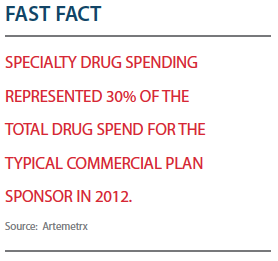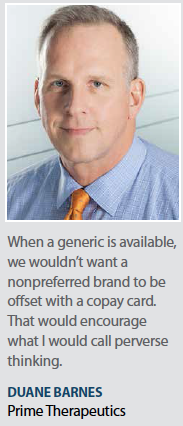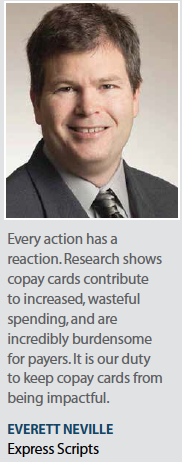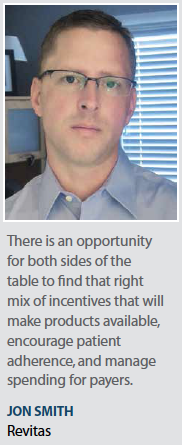Pharmacy benefit managers (PBM) over the last few years have been reverting to a once-common practice of closed formularies and formulary exclusions. This is happening, PBM leaders say, for a number of reasons, including the growing number of new and high-cost specialty products, cost increases above the rate of inflation, the increased use of “copay offsets," manufacturer coupons, and patient assistance programs.
Leaders in the PBM industry have questioned the use of these copay coupons, saying they take away patient incentives for choosing lower-cost alternatives. As a result, some pharmacy managers are taking back control and putting in place other measures for managing costs, including prior authorization requirements and even formulary exclusions.
“Current formulary trends will continue," says Jon Smith, VP, alliances and business development, Revitas. “There is a trend toward generics and tried-and-true therapies that are readily available at the least cost. I don’t think this is going to change any time soon. Payers will continue to add products to — rather than pull them from — their exclusion list."
tried-and-true therapies that are readily available at the least cost. I don’t think this is going to change any time soon. Payers will continue to add products to — rather than pull them from — their exclusion list."
Everett Neville, VP and chief trade relations officer, at Express Scripts, says the number of pharmaceutical company copay cards has grown, especially in areas with high-cost therapies, such as rheumatoid arthritis, multiple sclerosis, and growth hormones.
“Copay cards are extremely common now, particularly in the specialty arena," he says. “This makes sense because if a member’s copay is $500, a prescription is often left at the doctor’s office. The doctor, who 10 years or 15 years ago wrote a prescription and gave a sample, now gives the patient a card. This card is better than a sample, because it is not one dose; it basically pays the majority of the copay for as long as a patient is on the product.
“Specialty products are very expensive," he continues. “There are drugs that cost $85,000 for a three-month regimen; it doesn’t take long for that therapy to become a billion-dollar drug. Even $2,000 or $3,000 a month can add up quickly. In the majority of cases, there are alternatives. Where there is not an alternative, the copay programs are not as necessary because the drug is almost certainly covered."
 Express Scripts is one of the more vocal — and influential — companies criticizing the proliferation of copay cards. Mr. Neville says because of copay cards, tiered formularies are no longer effective in managing prescription drug costs.
Express Scripts is one of the more vocal — and influential — companies criticizing the proliferation of copay cards. Mr. Neville says because of copay cards, tiered formularies are no longer effective in managing prescription drug costs.
The company now has more than 70 products on the exclusion list for its Nation Preferred Formulary. On this list are recently approved products that had received the FDA’s breakthrough designation.
One of the more controversial moves was to exclude new hepatitis C drugs Sovaldi, Olysio, and Harvoni from the Express Scripts National Preferred Formulary. Last December, Express Scripts’ exclusion of Harvoni, Gilead’s treatment for chronic hepatitis C virus genotype 1 infection, which was approved in October 2014, generated a lot of press. Harvoni is priced at $1,125 per tablet, or more than $33,000 per a 30-day prescription.
Express Scripts instead will cover AbbVie’s Viekira Pak, which was approved in December 2014 also for the treatment of chronic genotype 1 (GT1) hepatitis C for all hepatitis C patients, not just those with advanced liver disease. (Sovaldi, Harvoni, and Olysio will continue to be available for patients who have already begun treatment regimens, and Sovaldi will be available for patients with other hepatitis C genotypes who have advanced liver disease.)
Express Script executives say they received a discount from AbbVie, which will save Express Scripts’ clients and members more than $1 billion this year on hepatitis C medications.
But other payers — United Healthcare, for example — have made the decision to cover Harvoni as its preferred hepatitis C product.
Express Scripts’ efforts to address high costs through exclusions go back to the early 2000s, when the company removed Lipitor from its formulary.
“At that time, Lipitor was the world’s biggest-selling drug, and our clinicians told us while it was a great drug, it wasn’t necessary," Mr. Neville says. “There were alternative products and, at the time, to meet the economics that were necessary for our payers, we excluded Lipitor. Ultimately, Pfizer was willing to work with us to meet our economic needs."
While Mr. Neville acknowledges that new drugs are more likely to have higher prices to account for higher development costs, he is concerned about the price increases for existing products.
 “Drug prices in aggregate had been going up by 3% to 4% and this relatively low rate could primarily be attributed to the generic wave," he says. “In the last three years, however, inflation for existing products has increased more than 10%. Our payers cannot sustain these annual increases and they look to Express Scripts to help control these rapidly rising costs."
“Drug prices in aggregate had been going up by 3% to 4% and this relatively low rate could primarily be attributed to the generic wave," he says. “In the last three years, however, inflation for existing products has increased more than 10%. Our payers cannot sustain these annual increases and they look to Express Scripts to help control these rapidly rising costs."
Mr. Smith of Revitas says it will take time to see the full impact of copay coupons.
“The advent of coupons is relatively recent," he says. “Research indicates that coupons immediately reduce out-of-pocket costs for the insured patient, but ultimately over time, they could increase overall healthcare spend."
This potential increase in overall costs is a result of manufacturers providing coupons for third- and fourth-tier products or those that are excluded from formulary.
“Manufacturers aren’t introducing coupons for drugs that are already on the preferred tier," Mr. Smith says. “It only makes sense that companies want to incentivize patients to go into the doctor and ask for a particular product."
Mr. Smith says there is a strategic opportunity for both payers and manufacturers to talk about how to structure programs.
“There will be different types of contracts that focus on both value-based contracting and outcomes-based contracting," he says. “There is an opportunity for both sides of the table to find the right mix of incentives that will make the products available, encourage patient adherence, and manage spending for payers."
Mr. Smith adds that, in the future contracting will evaluate not only pharmacy spend but the value of the product to the healthcare system.
“Because of the overall increase in costs at every point in the chain, people are going to be looking at the value they are getting for their money," he says. “This value needs to be expressed and quantified in terms of the outcomes for the patient and for the overall system, as well as the value that is gained by avoiding other costs, such as hospital readmissions, surgeries, and procedures."
As much as value continues to be a key criteria, a recent survey by EY found that cost is the No. 1 payer concern. Payers are focused on cost-containment and budgetary predictability over outcomes-based approaches.
Focus on Adherence
Other PBMs are evaluating the value of pharmaceutical copay cards from a slightly different perspective.
“Copay cards aren’t an all or nothing discussion," says Duane Barnes, chief operating officer of Prime Therapeutics, a PBM owned by 13 Blue Cross and Blue Shield plans. “There is a place where copay cards belong and a place where they do not belong. We don’t believe that copay cards are effective all the time. For example, when a generic equivalent is available, they can de-incentivize patients from using a cheaper alternative that’s equally safe and effective."
Mr. Barnes says where copay cards can play an important role is in the specialty drug area, which can help with patient adherence.
 “We believe that copay cards lower the out-of-pocket expense for the member, thus promoting adherence," he says. “We have done a lot of studies around adherence rates and the effect of out-of-pocket expenses. We’ve seen adherence rates decrease as the out-of-pocket expense goes up for a member or patient."
“We believe that copay cards lower the out-of-pocket expense for the member, thus promoting adherence," he says. “We have done a lot of studies around adherence rates and the effect of out-of-pocket expenses. We’ve seen adherence rates decrease as the out-of-pocket expense goes up for a member or patient."
Early in 2013, the health outcomes research team at Prime began measuring the effect of copay offsets. In the year-end analysis, the company found that coupon offsets saved Prime members more than $21 million on specialty drugs during the year. More than half of the members who regularly used Prime Therapeutics Specialty Pharmacy in 2013 received some form of copay offset, saving $1,069 yearly on average.
Prime’s research, as reported in the October 2014 issue of Health Affairs, also shows that high out-of-pocket costs damage medication adherence and persistence. This means members using the highest-cost medicines are more likely to skip taking the needed treatment or skimp on treatment to save money.
“As costs for members go up, a decline in adherence can actually have an impact on total care costs because it can lead to increased emergency room visits, hospital stays and other costs across the healthcare continuum," Mr. Barnes says.
The positive impact of copay coupons really only applies to high-cost drugs with few or no lower-cost alternatives.
Prime’s standard approach is to review all drugs for safety and efficacy first via its pharmacy and therapeutics committee. Going through this clinical filter ensures that Prime doesn’t evaluate drugs solely on price. If safety and efficacy are essentially equal, then the PBM can recommend to clients which drug or drugs should appear on formulary as a preferred agent.
“Our first choice is typically a generic, and if a patient needs a brand, we may require prior authorization to explain the purpose for the brand," Mr. Barnes says. “In these cases, we wouldn’t want a nonpreferred brand to be offset with a copay card. This would encourage what I call perverse thinking. This means coupons on nonpreferred drugs may circumvent efforts to encourage patients to use the most cost-effective drugs and risk increasing health care premiums. Brand pharma doesn’t like this."
Specialty Medications
Payers continue to worry about the pricing of specialty products, especially in areas such as high cholesterol and cancer. According to Express Scripts, more than one-third of all specialty drugs in development target cancer. And with projected costs of these drugs ranging between $35,000 and $75,000 per patient per year, there is cause for concern.
Additionally, payers express concern that much of this spend is not needed. Express Scripts predicts that U.S. health plan sponsors will spend $9.07 billion on specialty medication services that provide no additional value. Express Scripts data also show that plans that implement medical benefit management services have, on average, saved 10% to 15% on their specialty spending.
Specialty drug spending is expected to grow at double-digit rates for the next several years, in large part due to the pipeline of new specialty therapies coming to market, according to Artemetrx. They forecast that when aggregated across the pharmacy and medical benefits, specialty drug spending will surpass traditional (i.e., nonspecialty) drug spending by 2018.
“If we didn’t have strategies to manage costs through preferred drug and utilization management programs and contracting with pharma manufacturers we couldn’t be successful," Mr. Barnes says.
Mr. Barnes says Prime Therapeutics wants to partner with manufacturers to provide access, and the company employs a number of tactics to successfully manage drug spending; including a mix of preferred and nonpreferred drugs, management and strategies, such as prior authorization, care management teams to ensure side effects are being well-managed, preferred networks of pharmacies, as well as its own specialty pharmacy, to ensure the best rates can be contracted.
“We believe exclusions should be contemplated with care and we should make every effort to provide access for drugs that people are already taking," he says.
Mr. Barnes adds that biosimilars present an additional complexity in managing costs.
“I don’t think any of us can be certain how much costs we can take out of the system through the use of biosimilars," he says. “There are a lot of unknowns. The one thing we do know is that the rising costs of specialty drugs for very complex diseases and very complex therapies have to be better controlled. Bringing biosimilars to the U.S. market is just one way to manage these enormous costs that affect all parts of the healthcare system, including the patient."
A CVS Health Research Institute study released in January 2015 shows that enhanced prescription drug insurance can improve patient health outcomes and reduce use of other, often costly, healthcare services. Researchers found that while expanding insurance benefits may lead to initial cost increases, these costs should be offset by future reductions in spending associated with preventable patient morbidity and mortality.
Across the reviewed research studies, the authors observed a consistent link between drug insurance and improved patient health status. For example, when drug insurance programs were enhanced or expanded, more patients were able to afford important medications enabling them to access and adhere to prescription medicines for chronic conditions. This, in turn, decreased costly complications and overall healthcare use, including hospitalizations from unmanaged or under-managed conditions. Several studies also showed a negative impact on patient health outcomes when insurers placed burdensome caps on drug benefits. (PV)
~~~~~~~~~~~~~~~~~~~~~~~~~~~~~~~~~
Duane Barnes / Prime Therapeutics
Every action has a reaction. Research shows copay cards contribute to increased, wasteful spending, and are incredibly burdensome for payers. It is our duty to keep copay cards from being impactful.
Everett Neville / Express Scripts
There is an opportunity for both sides of the table to find that right mix of incentives that will make products available, encourage patient adherence, and manage spending for payers.
Jon Smith / Revitas
~~~~~~~~~~~~~~~~~~~~~~~~~~~~~~~~~


















